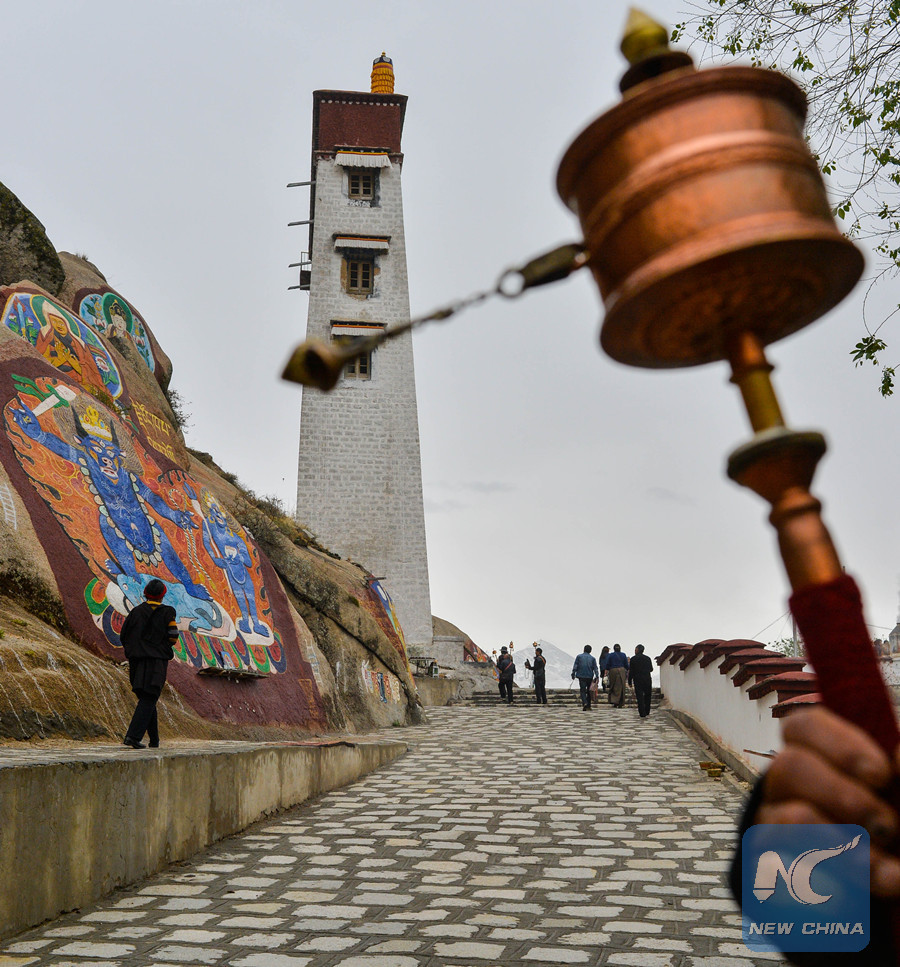Celebrating Saga Dawa in Tibet

Pilgrims perform full body prostrations on the Barkhor Street in the old area of Lhasa, capital of Southwest China's Tibet Autonomous Region on May 21, 2016. (Xinhua/Purbu Tashi)
On the Tibetan plateau, Saga Dawa is one of the most important religious festivals, and one of the best times to visit if you're interested in Tibetan Buddhism and culture.

Believers gather inJokhang Templein the old area of Lhasa, capital of Southwest China's Tibet Autonomous Region on May 21, 2016. (Xinhua/Purbu Tashi)

Pilgrimswalk around the Jokhang Templein the old area of Lhasa, capital of Southwest China's Tibet Autonomous Region on May 21, 2016. (Xinhua/Purbu Tashi)

Photo takenon May 21, 2016 showsJokhang Templein the old area of Lhasa, capital of Southwest China's Tibet Autonomous Region. (Xinhua/Purbu Tashi)
Saga Dawa falls on the full moon, or the 15th day, of the fourth month in Tibetan lunar calendar. It marks three important events of Sakyamuni, founder of Buddhism: his birth, enlightenment and attaining nirvana.

Believers gather inJokhang Templein the old area of Lhasa, capital of Southwest China's Tibet Autonomous Region on May 21, 2016. (Xinhua/Purbu Tashi)

A Lama makes decoration in Jokhang Temple in the old area of Lhasa, capital of Southwest China's Tibet Autonomous Region on May 21, 2016. (Xinhua/Purbu Tashi)
The whole month is actually considered sacred because of this auspicious day, so the celebrations run for the entire period.

Photo taken on May 21, 2016 shows incense smoke in front of a Buddha picturein the Jokhang Templein the old area of Lhasa, capital of Southwest China's Tibet Autonomous Region. (Xinhua/Purbu Tashi)
It is believed that good deeds and prayers are multiplied a thousand-fold during this month. So many people are immersed in prayers and carrying holy beads.

Photo taken on May 21, 2016 shows aprayer wheelagainst the background a tower in the Jokhang Templein the old area of Lhasa, capital of Southwest China's Tibet Autonomous Region. (Xinhua/Purbu Tashi)
All of Tibet is immersed in the festive and spiritual atmosphere. Events are held in many places on the plateau, but the Jokhang Temple, encircled by the thousand-year-old Barkhor Street in the old area of Lhasa, is the best place to see how Tibetans mark the festival. Visitors and believers are equally welcome.

Pilgrimswalk around the Jokhang Templein the old area of Lhasa, capital of Southwest China's Tibet Autonomous Region on May 21, 2016. (Xinhua/Purbu Tashi)
Walking around the temple or other sacred sites is a daily ritual, when pilgrims hold prayer wheels and walk clockwise around the temple from dawn to dark. Some have trekked thousands of miles to prostrate themselves before the sacred temple.

Pilgrimslight butter lamps in the Jokhang Templein the old area of Lhasa, capital of Southwest China's Tibet Autonomous Region on May 21, 2016. (Xinhua/Purbu Tashi)
The smell of burning incense and butter lamps fills the air. During this month, people also refrain from killing animals and give alms to anyone who asks.
Your Comment
Name E-mailRelated News
-
;
-
-

-
Buddhists in Tibet have faith in their religion and state
Drolma Yangkyi's first errand every morning is to change the offering water and tea and burn incense in front of the religious offering table.
-
-
-

-
Religion on the plateau
The article shows something people need to know about religion on the Qinghai-Tibet Plateau.
-
-
-

-
Looking into Bonism, original Tibetan religion
Many people tend to regard Tibetan society as strongly influenced by Buddhism, but actually many Tibetan customs are in fact originated from the Bon Religion.
-
Based in Lhasa, Tibet Vista is a Tibet travel agency that specialized in Tibet permit, and Tibet tours for both private and group travelers at a local price!
•4 Days Lhasa City Group Tour from USD 460 •8 Days Everest Base Camp Group Tour from USD 850 •15 Days Mt.Kailash Group Tour from USD 1780 •2016 Tibet Train Tours from Beijing, Shanghai, Chengdu, Xining,etc










